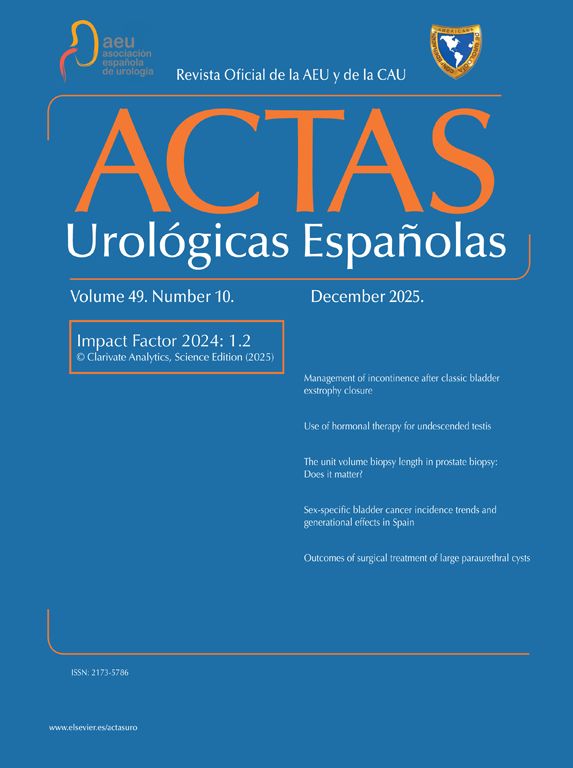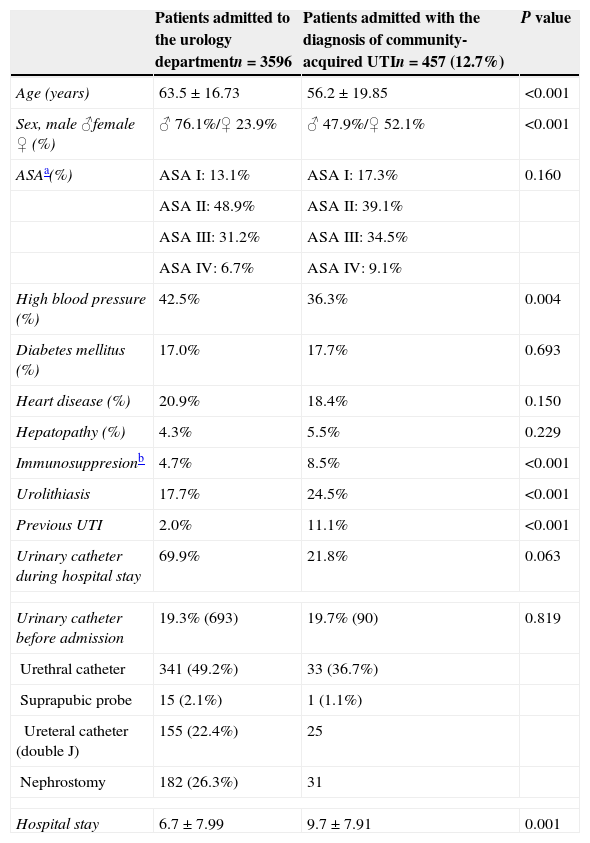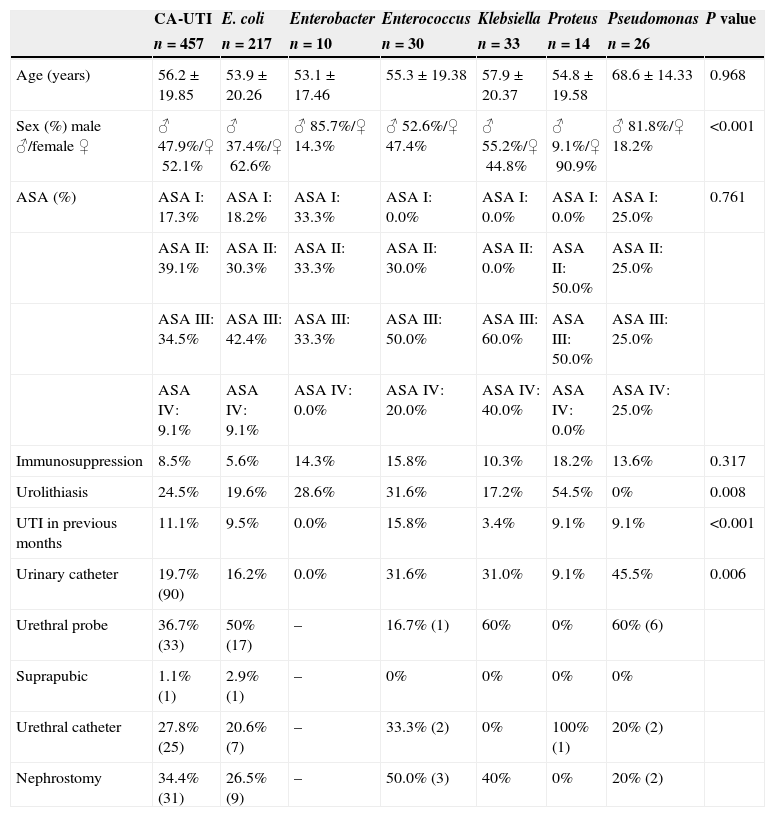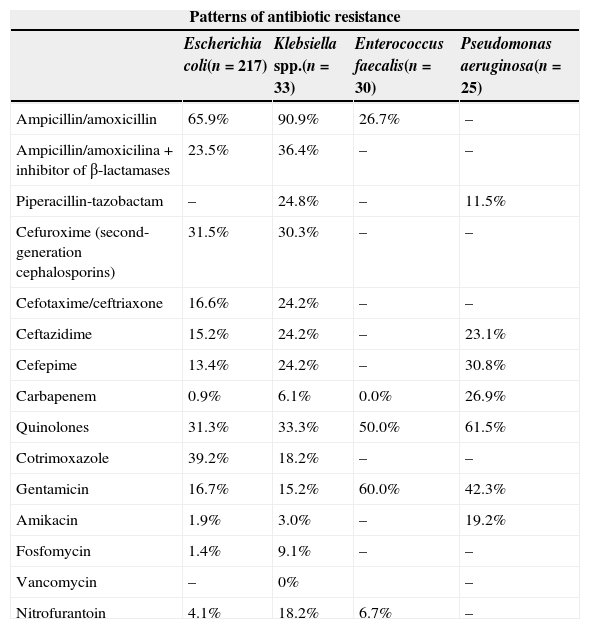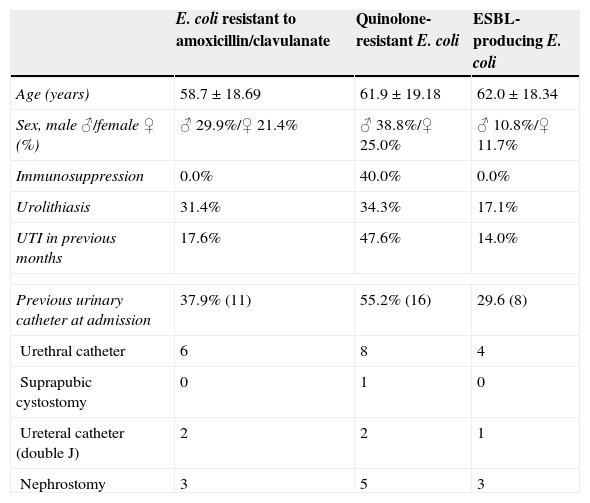Although patients with urinary tract infections (UTIs) are usually managed as outpatients, a percentage of them requires hospitalization. To review risk factors and microbiological characteristics of community-associated UTIs (CAUTIs) requiring hospitalization has been our objective.
Materials and methodsA prospective observational study was carried out from November 2011 to December 2013. Incidence, microbiological characteristics and antibiotic resistance patterns in patients with CAUTIs that required hospitalization were analyzed. Risk factors (including diabetes mellitus, urolithiasis, urinary catheterization) and resistance rates of each pathogen were also analyzed.
ResultsFour hundred and fifty-seven patients were hospitalized in our department with CAUTI. The mean age was 56.2±19.85 years. Of them, 52.1% patients were women, 19.7% had urinary indwelling catheter and 11.4% have had a previous UTI. The most frequently isolated pathogens were Escherichia coli (60.6%), followed by Klebsiella (9.2%), Enterococcus (8.4%) and Pseudomonas (7.2%). Enterobacteriaceae other than E. coli were more prevalent in male and older patients. On the other side the most frequently isolated pathogen in patients with a previous UTI and a urinary catheter was Enterococcus. The resistance rate of E. coli against ampicillin/amoxicillin+βlactamase inhibitor was 23.5%, against third-generation cephalosporins 16.6%, against fluoroquinolones 31.3% and 16.7% against aminoglycosides. 11.4% E. coli strains were producers of extended-spectrum beta-lactamases (ESBL). Finally, the resistance rates of Enterococcus and Pseudomonas against quinolones were of 50.0% and 61.5%, respectively.
ConclusionsCAUTIs that require hospitalization are most frequent in older age, male gender, and presence of urinary catheter, with urolithiasis and with previous episodes of UTI. These factors are also related to isolation of pathogens other than E. coli and higher resistance rates.
Las infecciones del tracto urinario (ITU) suelen manejarse ambulatoriamente. Sin embargo, un pequeño porcentaje requiere ingreso hospitalario. Nuestro objetivo fue analizar los factores de riesgo y características microbiológicas de las infecciones urinarias adquiridas en la comunidad (ITU-AC) que requieren hospitalización.
Material y métodosRealizamos un estudio prospectivo desde noviembre de 2011 a diciembre de 2013 evaluando la incidencia, factores de riesgo, patrones microbiológicos y tasas de resistencia en los pacientes con ITU-AC que requieren ingreso.
ResultadosCuatrocientos cincuenta y siete pacientes ingresaron en nuestro servicio con diagnóstico de ITU-AC. La edad media fue 56,2±19,85 años, el 52,1% eran mujeres, el 19,7% portaban catéter urinario y el 11,4% habían presentado ITU en los meses previos. Los microorganismos más frecuentemente aislados fueron Escherichia coli (60,6%), Klebsiella (9,2%), Enterococcus (8,4%) y Pseudomonas (7,2%). Enterobacteriaceae diferentes a E. coli fueron más frecuentes en pacientes de mayor edad. Enterococcus fueron más frecuentemente aislados en pacientes que habían tenido ITU previa y en aquellos portadores de catéter urinario. E. coli mostró unas resistencias del 23,5% para amoxicilina/ácido clavulánico, 16,6% para cefalosporinas de tercera generación, 31,3% para quinolonas y16,7% para aminoglucósidos. Del total de E. coli 11,4% fueron productores de betalactamasas de espectro extendido (BLEE). Los Enterococcus y Pseudomonas mostraron resistencias a quinolonas del 50,0% y 61,5% respectivamente.
ConclusionesITU-AC que requieren hospitalización se presentan más frecuentemente en varones de mayor edad, portadores de catéter urinario, litiasis urinaria y con episodios previos de ITU. Estos factores también se asocian con infecciones producidas por gérmenes diferentes a E. coli y altas tasas de resistencia.



